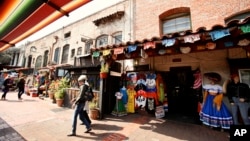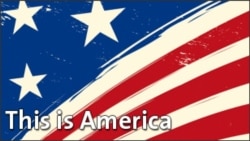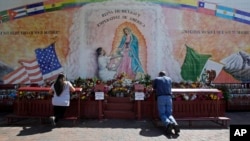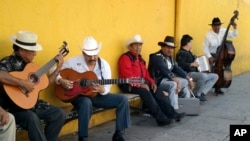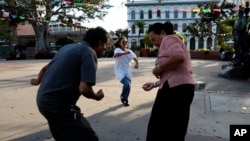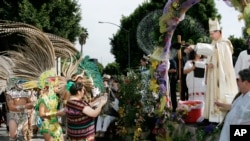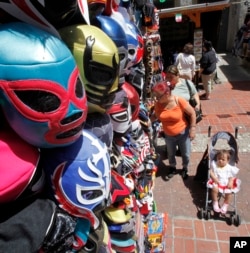Welcome to This Is America, from VOA Learning English. I’m Jonathan Evans.
And I’m Katherine Cole. Today we visit a Southern California street that leads back hundreds of years.
An unusual historical monument
The family stepped off a train at Union Station in Los Angeles. The mother looked around in the bright California sunshine and shook her head.
“Where are we?” she asked. “I thought this was supposed to be downtown – the center of the city.”
The woman had expected to be completely surrounded by huge office buildings. But instead, she and her family felt as if they had somehow landed in another time. Their train ride had led them to the oldest part of downtown Los Angeles. The visitors had stepped back through centuries of history.
They stood near the birthplace of Los Angeles, now the second largest city in the United States. They were close to where settlers and a few soldiers from Spain first set up the city in 1781. The settlers had left a nearby Roman Catholic religious center called Mission San Gabriel Arcangel. They wanted to set up a community on the edges of the river then known as Porciuncula.
Today, the place where the settlers started new lives is part of the El Pueblo de Los Angeles Historical Monument.
The word “monument” sometimes makes people think of a traditional statue – perhaps a man riding a horse. But this monument includes historic homes, museums and other buildings, parks, marketplaces, plazas and many artworks. It has places to rest, eat, play -- and places to think about what life was once like here.
Olvera Street
A marketplace and community-event center called Olvera Street form a lively part of the Historical Monument.
“La Placita Olvera aquies!”
Chances are it is busy on Olvera Street today. But then, energetic activity goes on here most of the time. People buy and sell things. Some people take lots of pictures. They stop for drinks, coffee and meals. And nearly every day, mariachi bands fill the air with song and music from the Spanish-speaking world. And you hear many other languages spoken as well.
Millions of tourists pass each year among Olvera Street’s puestos, or small businesses. They buy everything from imported leather goods to big hats, from dresses to shoes, from musical instruments to puppets hanging from strings.
Maybe you've seen Olvera Street before...
Olvera Street marks the heritage and the continuing relationship of the movie and television industry of Hollywood -- a Los Angeles neighborhood -- and nearby Burbank. Parts of movies and television shows are often filmed along Olvera Street and in the neighboring Plaza.
Long ago, silent film star Charlie Chaplin rescued child actor Jackie Coogan from a threatening welfare office in the 1923 movie “The Kid.”
A 1952 film called “The Ring” told about a Mexican-American prizefighter struggling to gain a better life. And Danny Glover and Mel Gibson ran toward the Plaza in the 1992 film “Lethal Weapon 3.”
More recently, Angelina Jolie and Brad Pitt danced there in the 2005 movie, “Mr. and Mrs. Smith.”
They danced in the center, or courtyard, of the Francisco Avila Adobe historic home. The building is said to be the oldest structure made of the material adobe in Los Angeles. A man named Francisco Avila had the home built in 1818.
Special days
Olvera Street is more than a tourist center and a movie set. It also has been used to mark or celebrate special events.
The Blessing of the Animals is a good example. During the ceremony, people present their animals to a religious leader who offers thanks for the creatures. Thousands of people bring cows, birds, cats, dogs, horses and other animals for the ceremony. Among the other animals are ferrets, lizards, llamas, ponies and rabbits.
Christopher Espinosa works as general manager of the El Pueblo de Los Angeles Historical Monument. He says his favorite event is All Souls Day -- the Day of the Dead. In Spanish, it is called El Dia de Los Muertos.
“It’s like the Mexican version of Halloween, and the main day lands on All Souls Day -- a time period where traditionally you respect the people who have passed.”
Mr. Espinosa described some of the event’s many activities on Olvera Street.
“And there’s altars with beautiful marigolds, and then there’s, like, a procession that occurs every day on Olvera Street and into the Plaza. And every night there’s dancing. And each day it builds bigger and bigger and bigger until the final day, the Dia de Los Muertos. And that day there’s this beautiful dance, and the place is jam packed.”
Mother of Olvera Street?
Olvera Street probably would not have existed without huge effort. That is especially true of the volunteer work and influence of a woman named Christine Sterling.
By the 1920s, large numbers of immigrants had arrived in California and other parts of the United States. The Avila Adobe and other historic buildings had fallen into poor condition. Ms. Sterling loved both history and Los Angeles. She heard that the oldest adobe structure in the city was threatened with destruction. And she started a campaign to save it.
People who wanted to rescue the Avila house donated money to repair and restore it. But not enough was raised. In 1928, the city government approved orders to condemn the home. But Mrs. Sterling followed with a note of her own. She accused officials of not caring about the city’s past.
Public opinion arose against destroying the old building. She and many in the public supported the return of the Avila Adobe and other places along Olvera Street to their former appearance.
Ms. Sterling appealed to Harry Chandler for help. He was publisher of the Los Angeles Times newspaper during that period. She described her dream of a colorful marketplace and cultural center to Chandler. Chandler’s newspaper aided her campaign. And he invited businessmen to fund-raising meals.
Harry Chandler was a powerful man. Other powerful people came to the expensive meals. With their help and that of others, the goal was reached.
On Easter Sunday, 1930, the dream of Mrs. Sterling and many people from that neighborhood came true. Olvera Street opened with the name “Paseo de Los Angeles.”
Visitors immediately made the area a success. Neighborhood people called it Olvera Street, the street’s postal-office name. It honored Agustin Olvera. He became the first county judge in the new County of Los Angeles in 1850.
The people that you meet
Ms. Sterling also helped people with special skills find a place to demonstrate those skills. For example, in the 1920s she visited Tijuana, Mexico. While there she saw skilled handmade craftwork by the father of a present Olvera Street businessman. She liked what she saw and invited the craftsman to work in Los Angeles. But he did not take the invitation seriously.
Jesus Hernandez is the son of that man. He tells the story.
“She (Ms. Sterling) told him, ‘I want to ask you to come to Olvera Street in Los Angeles. And my father said,’ Yeah, yeah, yeah, whatever.’ He was very young, he was probably mid-20s.”
Happily for the father and for Olvera Street, the man later received another invitation. His son remembers that time, he accepted.
Jesus Hernandez has a business on Olvera Street, just as his father did. He has operated the import store for many years. He says he sells “everything.”
“It’s not that I’m getting rich. But this is the tradition. This is what he taught me. This is the only thing I know how to do.”
America Tropical
A stone’s throw from the street is the Italian Museum of Los Angeles, home to a mural called America Tropical. The Mexican artist David Alfaro Siqueiros created the painting on an upper level outdoor wall overlooking Olvera Street. It is the only surviving public mural by Siqueiros in the U.S. that remains where it was painted.
Some experts say Siqueiros was a major Mexican artist of the 20th century. Some call him the father of the Los Angeles mural movement. Yet America Tropical was painted over and nearly destroyed. For many years, it was forgotten.
The mural shows a poor Mexican Indian tied onto a cross. An eagle above the Indian looks threatening. Critics said the mural accuses the U.S. of oppressing poor people. To many people in Los Angeles it was an unwelcome sight.
But over the years, defenders recognized the mural’s importance. They included experts from the Getty Conservation Institute. The Institute formed a partnership with the city. Thanks to a project costing millions of dollars, the painting has been brought as close as possible to its earliest condition.
People can study the mural, its artist and the methods experts used to save it in the America Tropical Interpretive Center. A special platform, a raised structure, provides visitors with a good look at the painting. They enter the platform through Sepulveda House in Olvera Street.
The history of Siqueiros’ work is one of many stories told on Olvera Street. It is a place of memories and images of America’s second largest city during the years Los Angeles invented itself.
This program was written by Jerilyn Watson. I’m Jonathan Evans.
And I’m Katherine Cole. Join us again next week for another This Is America from VOA Learning English.



